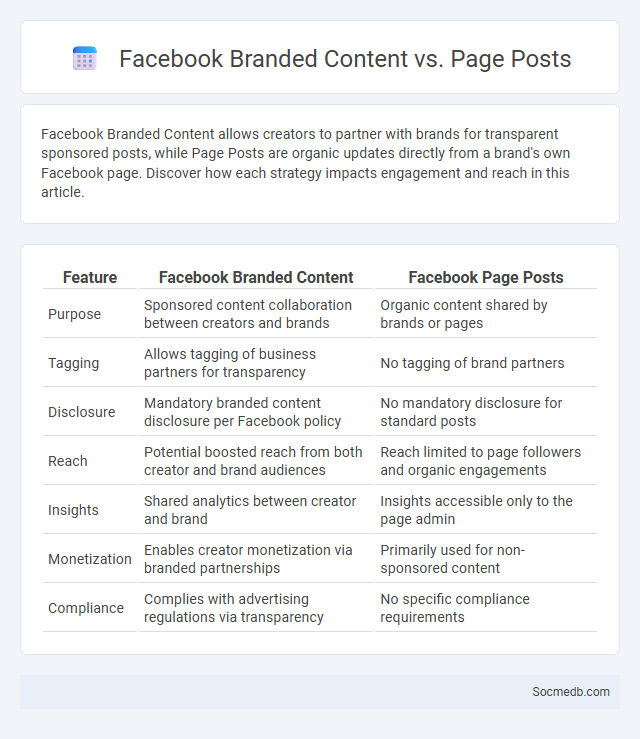
Photo illustration: Facebook Branded Content vs Page Posts
Facebook Branded Content allows creators to partner with brands for transparent sponsored posts, while Page Posts are organic updates directly from a brand's own Facebook page. Discover how each strategy impacts engagement and reach in this article.
Table of Comparison
| Feature | Facebook Branded Content | Facebook Page Posts |
|---|---|---|
| Purpose | Sponsored content collaboration between creators and brands | Organic content shared by brands or pages |
| Tagging | Allows tagging of business partners for transparency | No tagging of brand partners |
| Disclosure | Mandatory branded content disclosure per Facebook policy | No mandatory disclosure for standard posts |
| Reach | Potential boosted reach from both creator and brand audiences | Reach limited to page followers and organic engagements |
| Insights | Shared analytics between creator and brand | Insights accessible only to the page admin |
| Monetization | Enables creator monetization via branded partnerships | Primarily used for non-sponsored content |
| Compliance | Complies with advertising regulations via transparency | No specific compliance requirements |
Understanding Facebook Branded Content
Facebook Branded Content allows creators and businesses to collaborate by sharing sponsored posts that promote products or services while maintaining authenticity. Your content must clearly disclose these partnerships to comply with Facebook's transparency policies and enhance audience trust. Leveraging branded content tools on Facebook can increase engagement and reach by tapping into targeted demographics efficiently.
What Are Facebook Page Posts?
Facebook Page posts are content updates shared by business, brand, or community Pages to engage followers through text, images, videos, links, or events. These posts serve as a primary method for Pages to communicate news, promotions, and interactive material, boosting user interaction and organic reach. Optimizing Facebook Page posts with relevant keywords, hashtags, and call-to-actions enhances visibility in users' News Feeds and supports overall social media marketing strategies.
Key Features of Branded Content
Branded content on social media seamlessly integrates your brand's story with engaging visuals and narratives, fostering authentic connections with your audience. Key features include storytelling that reflects your brand values, native advertising that blends naturally within user feeds, and interactive elements like polls or tags that boost engagement. These components enhance brand awareness and encourage consumer trust, driving higher conversion rates and long-term loyalty.
Differences Between Branded Content and Page Posts
Branded content on social media involves collaborations where influencers or creators produce posts featuring a product or brand, explicitly tagging the brand to maintain transparency. Page posts originate directly from a brand's official social media page, allowing complete control over messaging and immediate audience engagement. Understanding these differences helps you tailor your marketing strategy to maximize authenticity and reach across platforms.
Audience Reach: Branded Content vs Page Posts
Branded content on social media typically achieves greater audience reach compared to standard page posts due to its native integration and collaboration with influencers or partners. Facebook reports that branded content often sees up to 30% higher engagement rates and extended visibility beyond organic followers. Leveraging branded content allows brands to tap into new, highly targeted demographics, enhancing overall campaign effectiveness.
Engagement Metrics Comparison
Engagement metrics on social media, including likes, comments, shares, and click-through rates, provide critical insights into audience interaction and content performance. Platforms like Instagram typically show higher engagement rates per post compared to Twitter and Facebook due to visual content appeal and algorithmic prioritization. Analyzing these metrics helps marketers optimize posting strategies, improve content relevance, and enhance overall campaign effectiveness.
Advertising and Boosting Options
Social media platforms offer a variety of advertising and boosting options designed to increase Your reach and engagement with targeted audiences. Tools like Facebook Ads Manager and Instagram Sponsored Posts enable precise demographic targeting, budget control, and real-time performance tracking. Leveraging these features can maximize Your campaign's effectiveness, driving higher conversion rates and brand awareness.
Brand Collaboration Opportunities
Social media platforms offer extensive brand collaboration opportunities by connecting your business with influencers and content creators who align with your target audience. Leveraging partnerships on Instagram, TikTok, and YouTube can boost brand visibility, engagement rates, and drive authentic user-generated content. Strategic collaborations enhance your digital presence, expand reach, and foster trust through credible endorsements in fast-evolving online ecosystems.
Compliance and Disclosure Requirements
Social media platforms require strict compliance with advertising guidelines set by regulatory bodies such as the Federal Trade Commission (FTC), mandating clear disclosure of sponsored content to prevent deceptive practices. Brands and influencers must use explicit labels like #ad or #sponsored to ensure transparency in paid promotions, aligning with platform-specific rules and legal standards. Failure to adhere to these compliance and disclosure requirements can result in penalties, reputational damage, and legal consequences.
Choosing the Right Format for Your Marketing Goals
Selecting the right social media format is crucial for maximizing your marketing goals, as each platform offers unique content options such as stories, reels, or carousel posts tailored to different engagement strategies. Understanding your audience's preferences and the specific performance metrics associated with formats like videos or static images helps optimize reach and conversion rates. You can enhance brand visibility and interaction by aligning content formats with your campaign objectives and platform algorithms.
 socmedb.com
socmedb.com